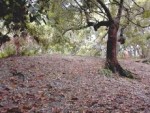USF students work to save sacred mound

USF archaeology and anthropology students are working with preservation groups to protect a Native American temple built more than a thousand years ago.
The two groups joined efforts in late June to preserve the 16-foot mound that was damaged and defaced by decades of abuse. The mound has been eroding into the surrounding streets, prompting action from the Greater Pinellas Point Civic Association (GPPCA).
“There are not that many things built that long ago,” said Claude Jenet, president of the association. “Secondly, this mound was a temple. For the Indian nation, this was a sacred place.”
For the USF students, the event provided an opportunity to put the information they have read in textbooks into a hands-on application.
They learned what it was really like to perform archaeology functions, said Chris Hunt, president of the anthropology club.
“They got to learn that it might be a little bit more difficult than they expected or that it’s dirtier than they expected,” he said.
The students worked with American Indian Movement Representative George Garcia, who provided support, permission and oversight to repatriate artifacts found on the mound while volunteers worked to install a new fence.
If someone found an artifact, especially a hand tool, Garcia repatriated it by digging a new hole, burying the artifact and then holding a ceremony, Hunt said. These activities were essential to preserving the tools’ sacredness.
Efforts to preserve the mound, declared a historical landmark in 2003, include planting drought-resistant plants, emplacing an erosion control structure and putting up caution signs.
The official name of the mound is the Pinellas Point Mound, but it has another name: the Princess Hirrihigua Mound.
Richard Estabrook of the Florida Public Archaeology Network said that the mound could be from the Weeden Island Period (between the years 200 and 900), just before the Spanish arrived in Florida.
The GPPCA is compiling a plan that will be submitted to the city of St. Petersburg by the end of July concerning what still needs to be done to protect the mound.
The plan will include building a walkway to the mound so people can view it while minimizing future potential for damage and erosion. It will also include planting more native and drought-resistant plants and erecting signs that detail the mound’s history.







